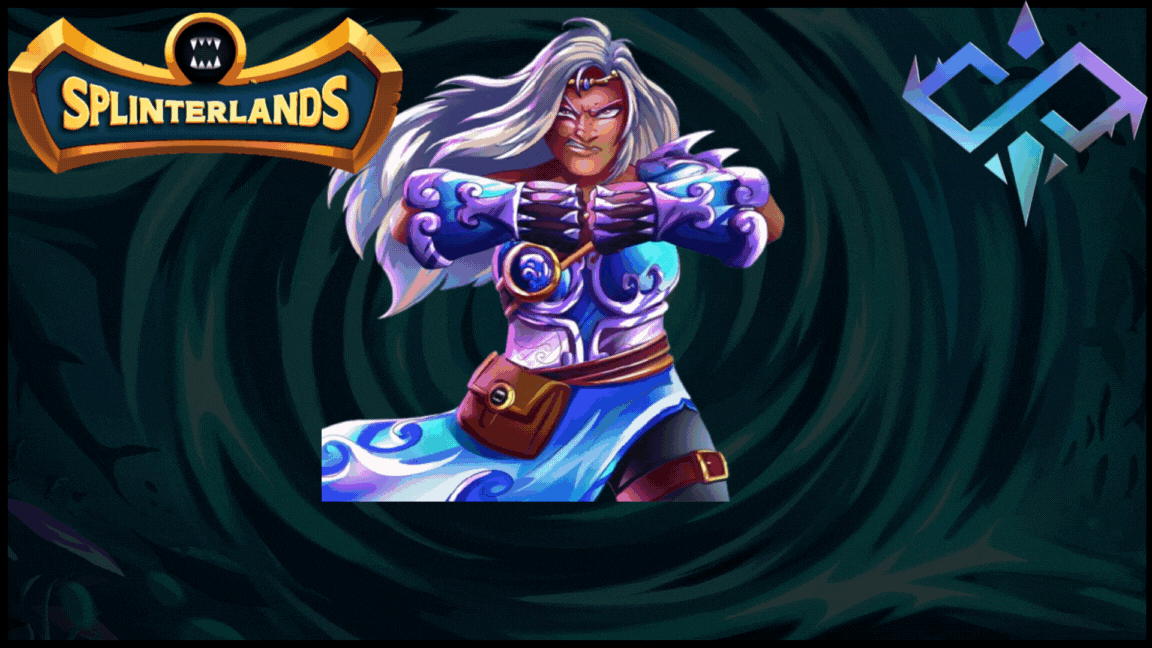

Hello, Splinterlands friends and family! 👋
For this week's Splinterlands Community Engagement Challenge, the @splinterlands team is inviting us to share our best battle strategies! 🛡️✨
This time, I’ve decided to highlight the power of the Water Splinter, using mostly Chaos Legion (CL) and CL reward cards. 🌊💎
For this strategy, I’ll showcase 2 battles from my alt account @javiss01, featuring simple and budget-friendly cards. 🃏💰
I hope you find this both entertaining and helpful! Let’s dive into the details! 🔍


Introduction: Why Water Splinter? 🤔
The Water Splinter has been one of the most powerful and versatile Splinters since the release of Chaos Legion (CL). 🌊 Even with the appearance of Rebellion (REB) cards, its dominance remains largely unchanged across leagues. 💪
I frequently use this strategy on my alt account, as it’s built without relying on inexpensive cards. Over the years, I’ve developed several budget-friendly strategies, leveraging my alt account, @javiss01, which primarily serves as a rental account and typically hovers between high Diamond and low Champion. 💎🏆
Why this strategy works:
- My alt account doesn’t feature any Rebellion cards and includes only a handful of cheap RiftWatchers (RW) cards I managed to rent for cheap. 🃏
- I’ve mastered the art of adapting this archetype to rulesets and mana restrictions, maximizing the value of CL core and Reward cards.
- This setup has proven effective even against powerful Tofu and Cryptic teams when opponents aren’t prepared for it. ⚔️🔥
What to expect in this post:
I’ll break down the strategy into three parts:
- A general overview of the strategy with detail description of each role and necessary cards.
- Variations based on different mana available.
- A highlight of 2 recent matches, showing how this strategy adapts to specific conditions. 🥇📝
Let’s dive into the details and see why Water Splinter remains a force to be reckoned with! 🚀✨

II. Why Water Splinter is a Must 🌊
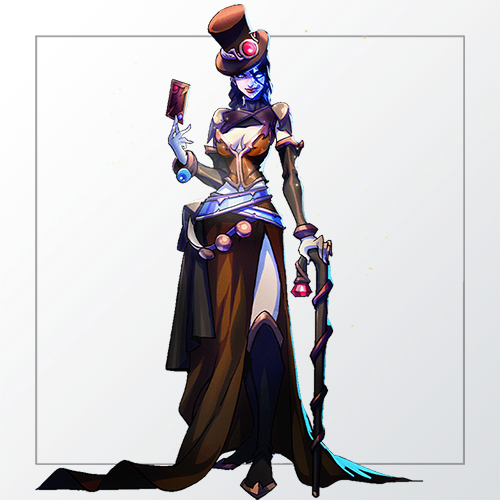
This strategy revolves around the Water Splinter and its key units, making it essential to have Water available in the match. 💧
🛡️ Key Points to Consider:
Summoners:
- Any summoner works, but Kelya Frendul and Lux Vega are the preferred choices due to their versatility and synergy with the cards.
The armor and speed provided by these summoners are usually vital for this strategy to work. As we will see this strategy relies on a taunt in the backline to protect the damage dealers and support units but when thats not posible or when the taunt dies fast for some reason its nice to have that extra armor provided by the summoner that most of the times will make the difference. - Dragon summoners like Quix the Devious or Lily Shieldpaw can also work, but they’re best reserved for no armor rulesets or when the mana cap is exceptionally high. 🐉
- Any summoner works, but Kelya Frendul and Lux Vega are the preferred choices due to their versatility and synergy with the cards.
Mana Requirements:
- Ideally, this strategy works best with 43+ mana. While it can function with less, it’s not optimal and may limit its effectiveness. ⚡
With these elements in place, you’ll be ready to execute this strategy effectively and dominate the battlefield! ⚔️✨
🛡️ Tank Combo
For this strategy, we’ll rely on a strong, beefy tank to hold the front line and give our backline Opportunity monsters time to shine. ⚔️
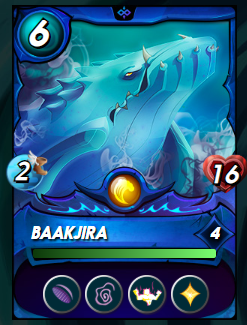
1st Option: Baakjira 🐋
Baakjira is your go-to tank in most cases:
- Mana Cost: 6
- Stats: 16 life, self-heal, and Void make Baakjira extremely tough, especially against magic attackers.
- Poison Rulesets: Baakjira thrives in poison matches due to its tanky nature and healing.
Although Baakjira doesn’t bring any offensive power, its primary role is to hold the frontline, allowing the rest of your team to deal damage.
Weakness:
- Debuffs: Anti-heal and other debuffs can cripple Baakjira, so consider adding a cleanse unit to your backline if you anticipate these.
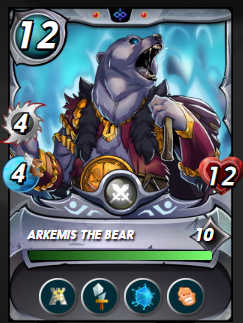
2nd Option: Arkemis the Bear 🐻
Arkemis is technically stronger than Baakjira in most scenarios but comes at a higher mana cost. This tank shines in matches where mana is abundant:
- Abilities: Forcefield and Protect are invaluable in high-mana matches, adding survivability for your entire team.
- When to Use: If the mana cap is 50 or more, Arkemis becomes your top choice.

3rd Option: Diemonshark and Commander Slade 🦈
When Baakjira and Arkemis aren’t available for any reason, Diemonshark and Commander Slade can step in as decent alternatives:
- Weakness: Both struggle against magic attackers, so avoid them in matches where magic is likely.
These tanks provide solid options depending on the ruleset and mana cap, ensuring you always have a reliable frontline for your strategy. 💪
🛡️ The Off-Tank: Kulu Mastermind 🐙
When it comes to off-tanks, one card stands above the rest: Kulu Mastermind.
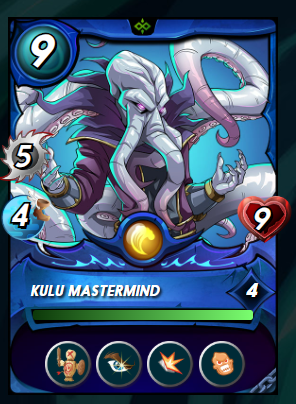
I’d go as far as to say that this card is essential for the success of this strategy. Let’s break down why:
🌟 Why Kulu Mastermind is a Game-Changer:
Weapons Training:
- Pairs exceptionally well with a main tank like Baakjira, who lacks attack power.
- While 3 damage on Baakjira isn’t game-changing, it’s still a free bonus that adds value.
Survivability:
- Shield: Reduces incoming damage, especially from melee and ranged attacks.
- Enrage: Boosts speed and attack when damaged, allowing Kulu to reach 6 speed, making it difficult to hit.
Offensive Power:
- Opportunity: Targets the weakest enemy, dealing consistent damage from the backline.
- Kulu, alongside Deeplurker, forms the core damage output of this strategy, taking down opponents in just a few turns.
🛠️ Strategic Role:
Kulu Mastermind is more than just an off-tank. It’s really a versatile powerhouse. It supports the frontline with Weapons Training, holds its ground with excellent defensive stats, and actively contributes to the offensive with Opportunity.
This card is, without a doubt, a must-have for this strategy to reach its full potential. 🔥
🎯 The Damage Dealers: Unleashing the Firepower
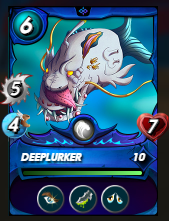
Core Damage Dealer: Deeplurker 🐟💥
When it comes to raw damage output, Deeplurker is usually the best option.
Why Deeplurker?
- Opportunity: Targets the weakest enemy, ensuring high-impact attacks.
- Offensive Power:
- Deals 5 damage, with a chance to apply Poison for extra pressure.
- One of the most efficient cards for eliminating backline threats.
- Relatively low cost. Will fit in most team compositions.
- Weakness:
- Only 7 life and no armor, making it vulnerable. However, its offensive kit makes up for the lack of defense. The main core of this strategy relies on protecting damage dealers like Deeplurker.
If Deeplurker isn’t available, other damage dealers can fill the gap, but it remains the preferred choice for this strategy.
🛡️ The 6th Spot: Wavebrood 🌊

Wavebrood is crucial for providing protection and utility with its Taunt ability, soaking up damage to shield your core units.
Key Attributes:
- High Durability: A large life pool combined with Void makes it resilient against magic attacks.
- Synergy: Paired with Silence from Angelic Mandarin, Wavebrood becomes even harder to take down in magic-heavy matches.
- Weakness: Vulnerable to melee and ranged attacks, but its high health allows it to hold the line long enough for your damage dealers to do their job.
💡 Flexible 4th and 5th Spots
Angelic Mandarin 🕊️
The 5th and 6th spot are usually the most interchangeable of all for this strategy. You usually want to place there some support units or even more damage dealer units. It all depends on rulesets and mana.

That being said I do consider Angelic Mandarin as almost always a must since it provides Triage, healing Wavebrood and keeping your backline alive longer.
Other Options:
For more versatility, consider these cards:
- Swamp Spitter: Offers a mix of ranged damage and utility.
- Supply Runner: Adds speed to your team, enhancing survivability and attack priority.
🌀 Low-Mana Damage Dealers

When the mana cap is tight you can also switch to low-cost damage dealers like these.
The cards with sneak are useful to combine with Opportunity since they will still attack the backline and eventually force the Opportunity attacks there. But any kind of low mana damage dealer can work.
These cards work well alongside Opportunity monsters, gradually focusing down the enemy backline.
🧩 Lineup Synergy
This lineup excels because of its strong synergy:
- Tank: A durable frontliner like Baakjira or Arkemis to absorb damage.
- Off-Tank: Kulu Mastermind serves as a great damage dealer and a great tank if the main tank falls.
- Backline Protection: Wavebrood and Angelic Mandarin keep your DPS protected and healed.
- Damage Dealers: Deeplurker and low-cost units relentlessly attack enemy weak points.
The result? A team that’s hard to kill and hits like a truck. 🚛💥

Now that we have the lineup ready lets take a look at a few fights:
📊 Battle Example: Strategy in Action
As I explained above, the strategy is highly adaptable.
In this case, since it was only a 37-mana fight, I couldn’t fit in Wavebrood. Wavebrood is a pivotal part of the strategy, but you can manage without it, especially if Aimless is one of the rulesets, as Taunt won’t affect magic and ranged attacks.
For this fight, I decided to include two cheap damage dealers: Pelacor Bandit and Shock Trooper. Since the mana cap wasn’t very high, I had to settle for these two options.
🔥 Turn 1:

In the first turn, my Deeplurker and Kulu Mastermind focused on the enemy's Queen Mycelia, eliminating her immediately with Opportunity attacks.
⚔️ Turn 2:

At the start of turn 2, my Kulu was ready to take out another unit from the enemy lineup. This time, the backline took the hit since Pelacor Bandit was already dealing damage to it.
This highlights exactly how Pelacor Bandit or any kind of sneak monster fits into this lineup. You want to focus on the enemy backline with your Opportunity monsters, and having Pelacor deal some additional damage is always useful for that purpose.
✅ Outcome:
Without proper defense, the enemy team crumbled under the pressure of Opportunity and sustained damage. My Baakjira easily healed through the little damage it took, while my backline dismantled the opposition.
This match demonstrated how even without Taunt, this strategy’s high damage output can overwhelm opponents lacking defensive tools.

I know this post is getting long, but I’d like to feature another fight showcasing the strategy working as intended 100%.
For this battle, we have what I call a "classic setup" for this strategy. Everything is in its place. The 51-mana cap allowed me to play Arkemis the Bear as the frontline tank and Swamp Spitter in the backline as an additional support card. 🛡️✨

In just one turn, my Opportunity monsters managed to take out the enemy Deeplurker. 🐟💥 With only 2 health left and already poisoned, the card was as good as gone.

By the start of Round 2, things were looking great. One enemy unit was down, and both of my tanks were holding strong. Although Wavebrood was struggling to survive another turn, it had already fulfilled its role. 🛡️👌

In Turn 3, Wavebrood miraculously survived thanks to Angelic Mandarin's Triage. Meanwhile, the enemy's Sea Stalker was close to being taken out because Wavebrood was reflecting the damage. 🩸🔮

By Turn 4, Wavebrood finally fell. However, the enemy tank was eliminated, thanks to the combined efforts of Arkemis and Swamp Spitter. With Arkemis in the frontline, you gain a powerful damage dealer capable of independently taking down multiple units. 💪🔥

A few turns later, the battle concluded. The opponent relied on tanky units, which prolonged the match, but their lack of sufficient damage output meant my remaining team stood victorious. 🏆✨
This battle is a textbook example of this strategy in action. It highlights the core principles: a strong frontline tank, synergistic support units, and devastating Opportunity attacks. While this strategy may struggle against overpowered cards like Tofu or Cryptic, it excels in high Gold and low Diamond ratings, where such cards are less common. 🚀🎯


🏁 Conclusion – Final Thoughts
Conclusion: A Winning Formula 🌊🏆
The Water Splinter strategy showcased in this post is a testament to how effective budget-friendly setups can be, even in competitive environments. By leveraging synergy between durable tanks like Baakjira or Arkemis, versatile support units like Wavebrood and Angelic Mandarin, and devastating Opportunity attackers like Kulu Mastermind and Deeplurker, this lineup offers a solid foundation for success.
What makes this strategy truly shine is its adaptability. Whether you're dealing with low or high mana caps, poison rulesets, or challenging opponents, you can tweak the lineup to suit your needs. Even without high-priced cards like Rebellion staples, this setup holds its own and can consistently perform well in high Gold or low Diamond ranks. 💪✨
While it may fall short against the most overpowered meta cards like Tofu or Cryptic, the beauty of this strategy lies in its simplicity and accessibility. It’s a reliable approach for those looking to climb the ranks without breaking the bank. 🃏💸
Thank you for reading, and I hope this guide helps you improve your gameplay or inspires you to try out a similar approach! If you have questions or want to share your own strategies, feel free to leave a comment. Let’s keep learning and growing together in the Splinterlands community! 🌟💬
Also if you want to check out my latest post you can by clicking the images:
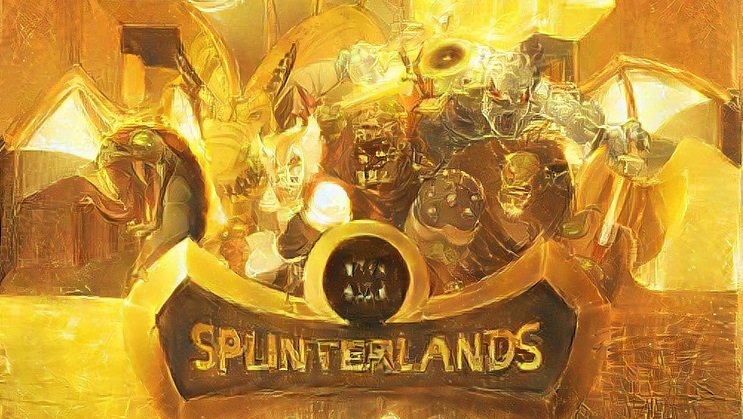
| SPLINTERLANDS.COM - Referral Link | SPLINTERSHARDS (SPS) | BLOG | DISCORD | TELEGRAM |
#splinterlands #play2earn #challenge





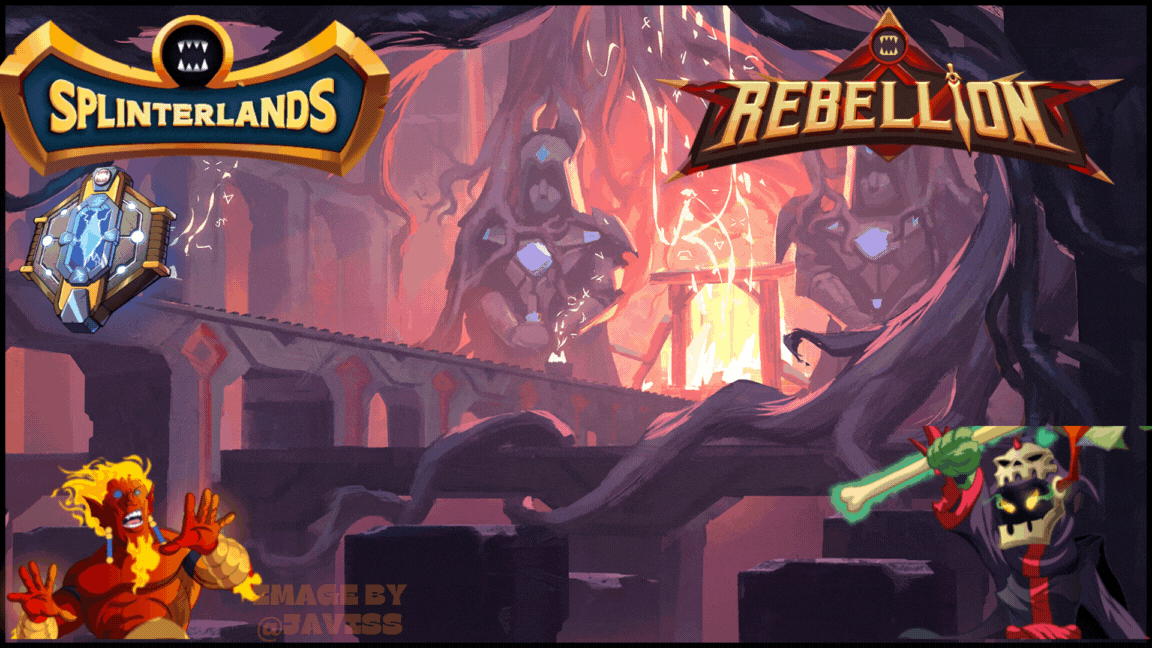
Sending Love and Ecency Curation Vote!
 Follow Eceny's curation trail to earn better APR on your own HP. : )
Follow Eceny's curation trail to earn better APR on your own HP. : )
thanks for the support!
Congratulations @javiss! You have completed the following achievement on the Hive blockchain And have been rewarded with New badge(s)
Your next target is to reach 50 posts.
You can view your badges on your board and compare yourself to others in the Ranking
If you no longer want to receive notifications, reply to this comment with the word
STOPThanks for sharing! - @libertycrypto27

great strategy and great post!
thanks for the support @libertycrypto27 !